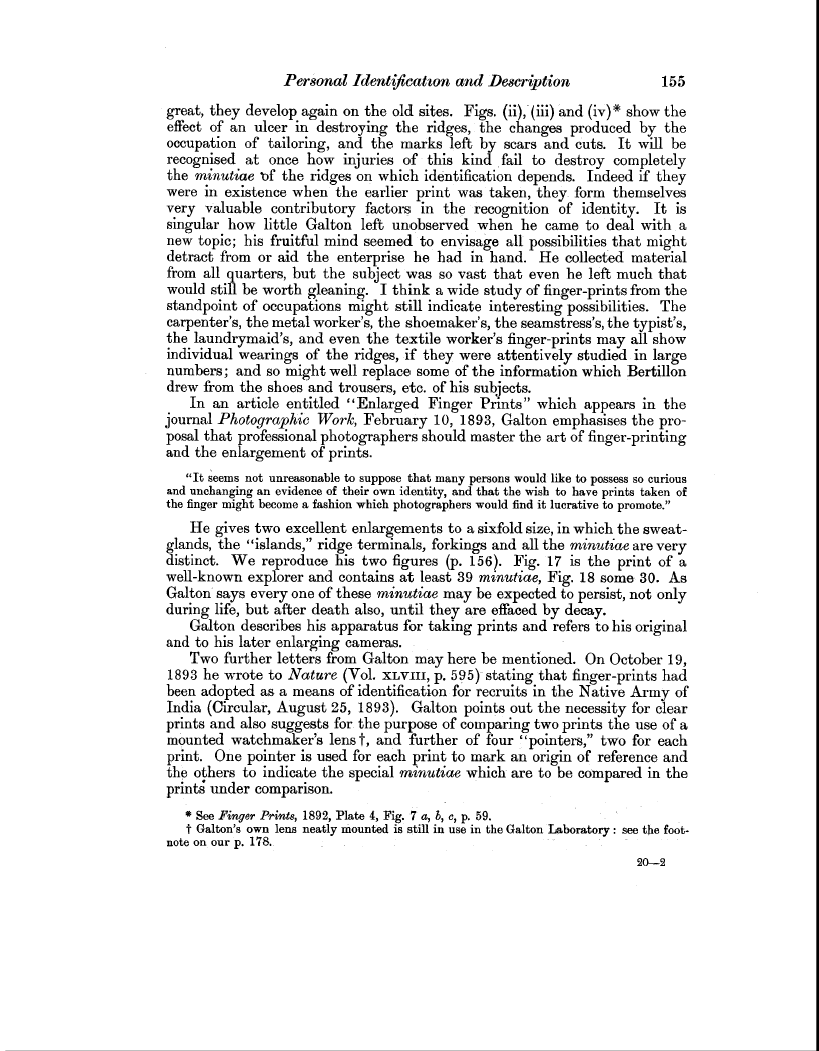| ||||||

OCR Rendition - approximate
Personal Identification and Description 155 great, they develop again on the old sites. Figs. (ii),-(iii) and (iv)* show the effect of an ulcer in destroying the ridges, the changes produced by the occupation of tailoring, and the marks left by scars and cuts. It will be recognised at once how injuries of this kind fail to destroy completely the minutiae -of the ridges on which identification depends. Indeed if they were in existence when the earlier print was taken, they form themselves very valuable contributory factors in the recognition of identity. It is singular how little Galton left unobserved when he came to deal with a new topic; his fruitful mind seemed to envisage all possibilities that might detract from or aid the enterprise he had in hand. He collected material from all quarters, but the subject was so vast that even he left much that would still be worth gleaning. I think a wide study of finger-prints from the standpoint of occupations might still indicate interesting possibilities. The carpenter's, the metal worker's, the shoemaker's, the seamstress's, the typist's, the laundrymaid's, and even the textile worker's finger-prints may all show individual wearings of the ridges, if they were attentively studied in large numbers; and so might well replace some of the information which Bertillon drew from the shoes and trousers, etc. of his subjects. In an article entitled "Enlarged Finger Prints" which appears in the journal Photographic Work, February 10, 1893, Galton emphasises the proposal that professional photographers should master the art of finger-printing and the enlargement of prints. "It seems not unreasonable to suppose that many persons would like to possess so curious and unchanging an evidence of their own identity, and that the wish to have prints taken of the finger might become a fashion which photographers would find it lucrative to promote." He gives two excellent enlargements to a sixfold size, in which the sweat glands, the "islands," ridge terminals, forkings and all the minutiae are very distinct. We reproduce his two figures (p. 156). Fig. 17 is the print of a well-known explorer and contains at least 39 minutiae, Fig. 18 some 30. As Galton says every one of these minutiae may be expected to persist, not only during life, but after death also, until they are effaced by decay. Galton describes his apparatus for taking prints and refers to his original and to his later enlarging cameras. Two further letters from Galton may here be mentioned. On October 19, 1893 he wrote to Nature (Vol. XLVIII, p. 595) stating that finger-prints had been adopted as a means of identification for recruits in the Native Army of India (Circular, August 25, 1893). Galton points out the necessity for clear prints and also suggests for the purpose of comparing two prints the use of a mounted watchmaker's lens t, and further of four "pointers," two for each print. One pointer is used for each print to mark an origin of reference and the others to indicate the special minutiae which are to be compared in the prints under comparison. * See Finger Prints, 1892, Plate 4, Fig. 7 a, b, c, p. 59. t Galton's own lens neatly mounted is still in use in the Galton Laboratory : see the footnote on our p. 178. - 20-2
|